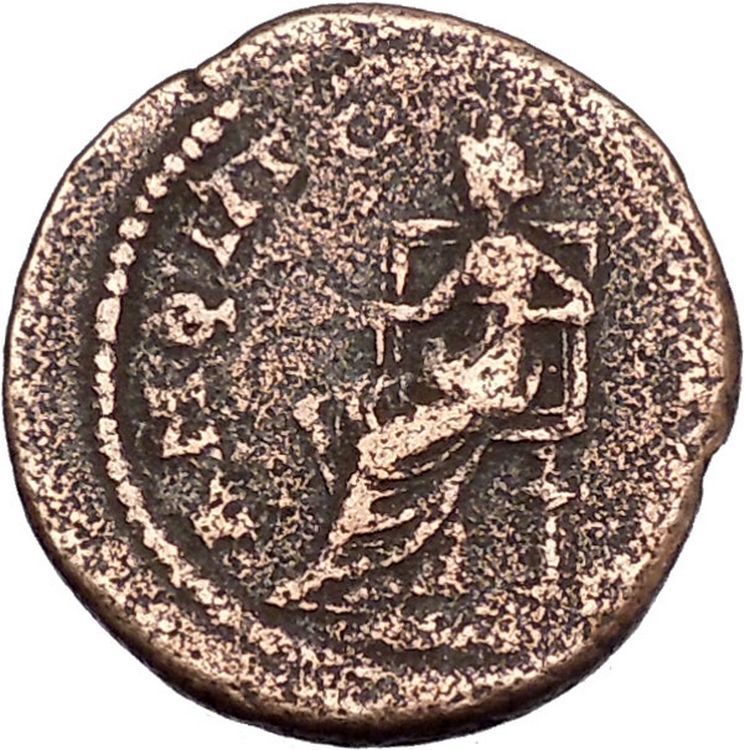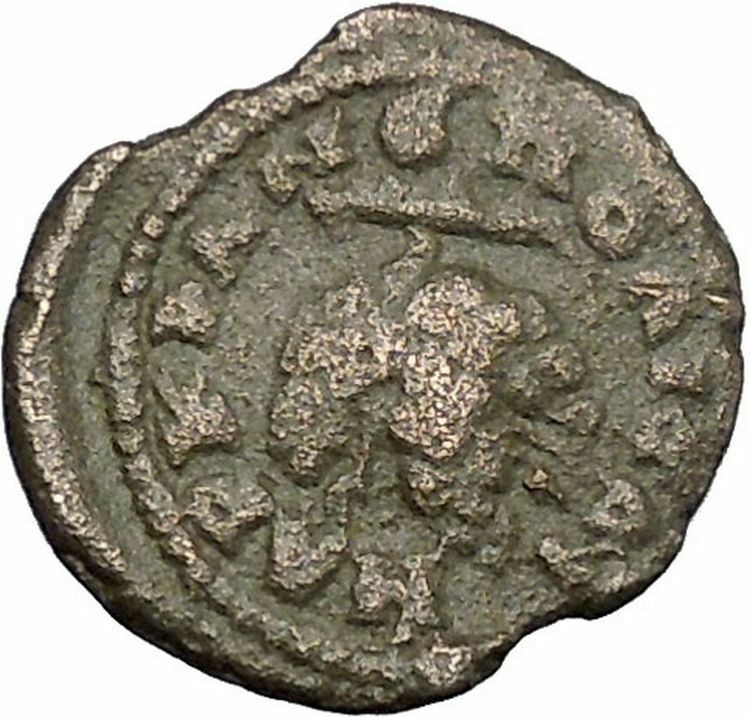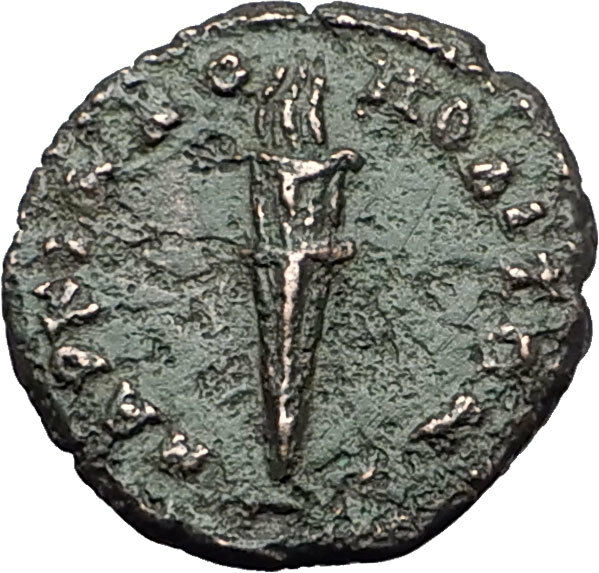|
Philip II – Caesar: 244-247 & Roman Emperor: 247-249 A.D.
Bronze 28mm (15.79 grams) of Viminacium
Year 9 of the founding of Viminacium, struck circa 247/248 A.D.
Reference: BMC.- – SNG/H.361 pl. XXXI – AMNG. 1/119 – Varbonov157 (R8) (250?) – Kotschev2 /29-1
IMP PHILIPPVS AVG. laureate, draped & cuirassed bust right.
P M S COL VIM, Moesia standing left between bull & lion, AN VIIII in exergue.
* Numismatic Note: Rare type of Philip II, showing him as an emperor with the AVG title.
Viminacium was a major city of the Roman province of Moesia (today’s Serbia), and the capital of Moesia Superior. Viminacium was the base camp of Legio VII Claudia, and hosted for some time the Legio IIII Flavia Felix. The bull and the lion depicted on the coins from the city were the symbols of the two legions. It was destroyed in 440 by the Huns.
You are bidding on the exact item pictured, provided with a Certificate of Authenticity and Lifetime Guarantee of Authenticity.
Legio quarta Flavia Felix (“Lucky Flavian Fourth Legion”), was a legion of the Imperial Roman army founded in AD 70 by the emperor Vespasian (r. 69-79) from the ashes of the Legio IV Macedonica. The legion was active in Moesia Superior in the first half of the 5th century. The legion symbol was a lion.
During the Batavian rebellion, the IV Macedonica fought for Vespasian, but the emperor distrusted his men, probably because they had supported Vitellius two years before. Therefore IV Macedonica was disbanded, and a new Fourth legion, called Flavian Felix was levied by the emperor, who gave the legio his nomen, Flavia. Since the symbol of the legion is a lion, it was probably levied in July/August 70.
IV Flavia Felix was camped in Burnum, Dalmatia (modern Kistanje), where it replaced XI Claudia. After the Dacian invasion of 86, Domitian moved the legion to Moesia Superior, in Singidunum (modern Belgrade, Serbia), although there is some evidence of the presence of this legion, of one of its vexillationes in Viminacium (near modern-day Kostolac, Serbia), base of VII Claudia.
In 88 the Fourth participated to the retaliation invasion of Dacia (see Domitian’s Dacian War). It also participated in the Dacian Wars of Trajan, being victorious at the Second Battle of Tapae. The legion also participated at the final and decisive battle against the Dacians, conquering their capital, Sarmisegetusa.
Monuments of IV Flavia Felix have been found at Aquincum (Budapest). This suggests that a subunit replaced II Adiutrix during its absence during the wars of Lucius Verus against the Parthian empire (162-166).
In the Marcomannic Wars (166-180 AD), the fourth fought on the Danube against the Germanic tribes.
After the death of Pertinax, the IV Flavia Felix supported Septimius Severus against usurpers Pescennius Niger and Clodius Albinus.
The legion may have fought in one of the several wars against the Sassanids, but stayed in Moesia Superior until the first half of the 5th century.
This Roman Legion was featured in the beginning of the movie Gladiator where Maximus Decimus Meridius was the Legion general, leading the campaign in Germania against the Marcomanni.
Legio septima Claudia Pia Fidelis (Seventh Claudian Legion) was a Roman legion. Its emblem, as well as of all Caesar’s legions, was the bull, together with the lion.
The 7th, along with the 6th, 8th & 9th were all founded by Pompey in Spain in 65 BC. They were ordered to Cisalpine Gaul around 58 BC by Julius Caesar, and marched with him throughout the entire Gallic Wars.
Legio VII was one of the two legions used in Caesar’s invasions of Britain, and played a crucial role in The Battle of Pharsalus in 48 BC, and it existed at least until the end of the 4th century, guarding middle Danube.
Tiberius Claudius Maximus the Roman soldier who brought the head of Decebalus to emperor Trajan was serving in Legio VII Claudia.
Viminacium (VIMINACIVM) was a major city (provincial capital) and military camp of the Roman province of Moesia (today’s Serbia), and the capital of Moesia Superior. The site is located 12 km from the modern town of Kostolac in Eastern Serbia. The city dates back to the 1st century AD, and at its peak it is believed to have had 40.000 inhabitants, making it one of the biggest cities of that time. It lies on the Roman road Via Militaris. Viminacium was devastated by Huns in the 5th century, but was later rebuilt by Justinian. It was completely destroyed with the arrival of Slavs in the 6th century. Today, the archeological site occupies a total of 450 hectares, and contains remains of temples, streets, squares, amphitheatres, palaces, hippodromes and Roman baths.
History
The remains of Viminacium, the capital of the Roman province of Moesia Superior, are located on territories of the villages of Stari Kostolac and Drmno, about 12 km from the town of Kostolac and about 90 miles southeast of Belgrade. Viminacium was one of the most important Roman cities and military camps in the period from 1st to 4th centuries. Its exceptional strategic importance was reflected both in the defense of the northern border of the Roman empire and in turn of communications and commercial transactions. No less appealing to the Romans was the hinterland of the Mlava river valley, which is rich in ore and grains. In Roman times, the town on the northern side of relying directly on the branch of the Danube, while the western side, touching the walls Mlava rivers. Only in the later period, Viminacium spread to the left bank of Mlava. Thanks to the location, land and waterways, Viminacium represented one of those areas where the encounter of cultures between East and West was inevitable. Although these roads were the primary military and strategic function, they are taking place throughout antiquity very lively traffic and certainly contributed to the very Viminacium become prosperous and an important trading and business headquarters. In Viminacium, Roman legion VII Claudia was stationed, and a nearby civilian settlement emerged from the military camp. In 117 during the reign of Hadrian it received city status. In the camp, 6.000 soldiers were stationed, and 30-40.000 lived nearby. In the first half of the 3rd century the city was in full development, as evidenced by the fact that at that time it acquired the status of a Roman colony, and the right to coin local money. Here, in 211, Septimius Severus was proclaimed emperor by his son Caracalla. In the mausoleum and the excavated tombs, the Roman emperor Hostilian, who died in 251, was buried.
A legion may have been stationed here as early as Augustus (27 BC-14 AD). In 33/34 AD a road was built, linking Viminacium and Ratiaria. Claudius (41-54) garrisoned Viminacium, Oescus and Novae as camps for the Moesian legions.
The first legion attested at Viminacium was the VII Claudia that came from Dalmatia in 52 AD .
Emperor Trajan (98-117) was headquartered here during the Dacian Wars. It became a colonia with minting privilege in 239 AD during the rule of Gordian III (238-244) and housed the Legion VII and Legion IV.
Emperor Hostilian was the son of the emperor Decius, who was killed in the ambush near the ancient city of Abrutus located in present day Bulgaria. According to the old manuscript, emperor Hostilian and his mother came to Viminacium to supervise the organization of defense of northern borders, but both of them died of the plague. Because of the distance and the fear of spreading the plague, he was buried with all honors in Viminacium
Viminacium was the provincial capital of Moesia Superior. In the late spring of 293-294, Diocletian journeyed through his realm and he re-organized Viminacium as the capital of the new province of Moesia Superior Margensis. He registered that the people wrote in Latin, as opposed to Greek in the southern provinces. Viminacium was the base camp of Legio VII Claudia, and hosted for some time the IIII Flavia Felix. It had a Roman amphitheatre with room for 12,000 people.
In 382 the city was the meeting place between Theodosius and Gratian amidst the Gothic Wars.
Viminacium was destroyed in 441 by the Attila the Hun, but rebuilt by Justinian I. During Maurice’s Balkan campaigns, Viminacium saw destruction by the Avars in 582 and a crushing defeat of Avar forces on the northern Danube bank in 599, destroying Avar reputation for invincibility.
Location and excavation
Viminacium is located in Stari Kostolac (Old Kostolac) a Serbian town on the Danube river, east of Belgrade. Viminacium is the location of the first archaeological excavation in Serbia, which started in 1882, by Mihailo Valtrović, an architect by profession and the first professor of archeology at the college in Belgrade. The only help he received was from 12 prisoners, because the state did not have enough resources to provide him with a better work force. His research was continued by Miloje Vasić, in the 1970s. It has intensified in the last ten years in the area of the Roman city of the Roman legionary camps and cemeteries. Many studies suggest that the military camp at Viminacium had a rectangular plan, measuring 442 x 385 meters, and that is not far from its western wall of civilian settlement in an area of approximately 72 acres. Legionary camp in Viminacium is now in a layer of arable land, so that wealth Viminacium easily accessible to researchers, but, unfortunately, and the robbers.The National Museum in Belgrade and Požarevac kept some 40,000 items found in Viminacium, of which over 700 made of gold and silver. Among them are many objects that represent the European and world rarities invaluable.
It has been discovered and more than 13,500 graves. Tombstones and sarcophagi are often decorated with relief representations of scenes from mythology or daily life. We have found numerous grave masonry construction. Especially interesting are the frescoes of the 4th-century tombs. Fresco with the notion of young women in artistic value of the extreme range of late antique art. During the excavation, an amphitheater, which with its 12,000 seats was one of the largest in the Balkans.
 Philip II – 247-249 A.D. Philip II – 247-249 A.D.
Caesar: 244-247 A.D. (under Philip I) | Augustus: 247-249 A.D. (with Philip I)
Son of Philip I ‘The Arab’ and Otacilia Severa | Grandson of Julius Marinus
Marcus Julius Philippus Severus, also known as Philippus II, Philip II and Philip the Younger (238-249) was the son and heir of the Roman Emperor Philip the Arab by his wife Roman Empress Marcia Otacilia Severa. According to numismatic evidence, he had a sister called Julia Severa or Severina, whom the ancient Roman sources do not mention.
When his father became emperor in 244 he was appointed Caesar. Philippus was consul in 247 and 248. His father was killed in battle by his successor Decius in 249. When news of this death reached Rome, he was murdered by the Praetorian Guard. He died in his mother’s arms. When he died, he was eleven years old.
|





 Philip II – 247-249 A.D.
Philip II – 247-249 A.D.




